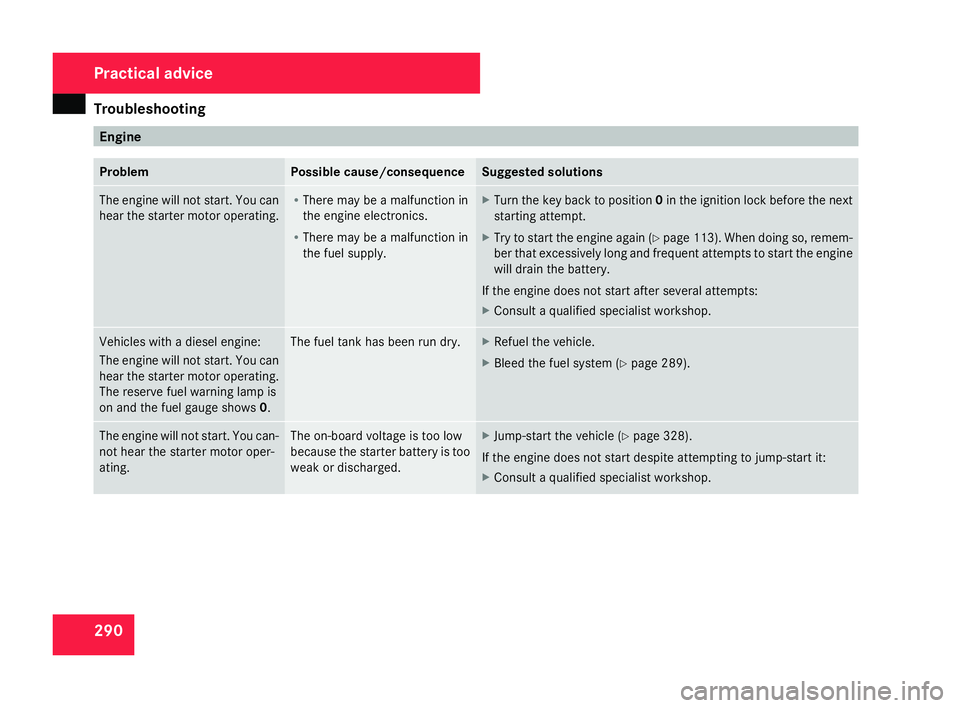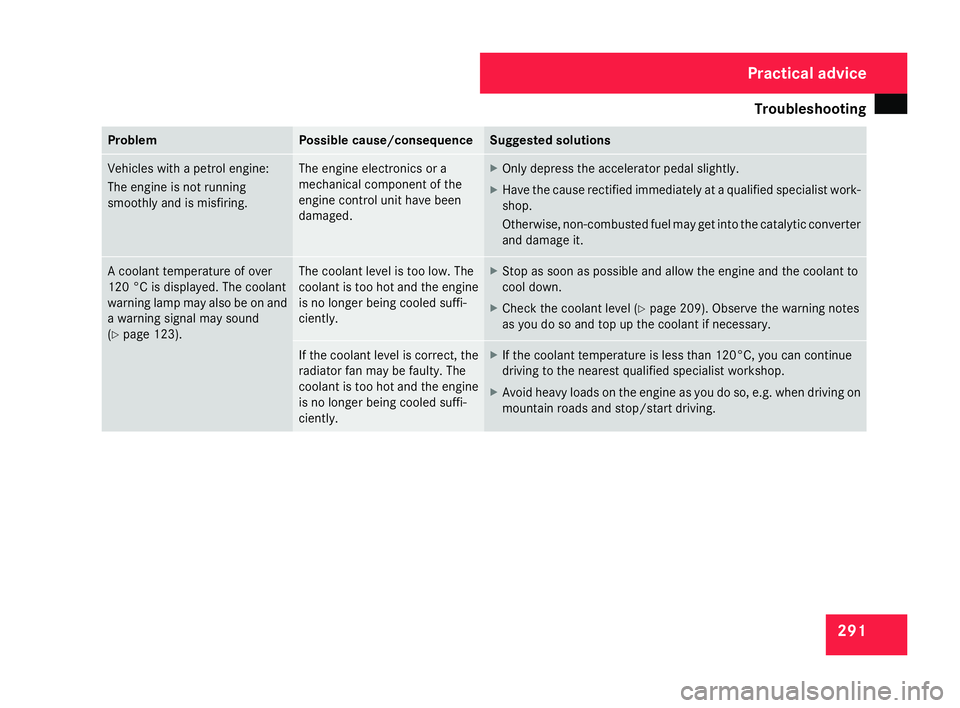Page 285 of 377

Troubleshooting
28
2 Problem Possible cause/consequence Suggested solutions
D
The red coolant warning
lamp lights up while the
engine is running. You will
also hear a warning tone. The coolant temperature has
exceeded 130
†. The engine is
not being cooled sufficiently and
may be damaged .
The coolant level may be too low. X
Stop the vehicle as soon as possible. Pay attention to the traffic
conditions as you do so.
X Allow the engine and coolant to cool.
X Check the coolant level. Observe the warning note s
( Y page 209). Top up the coolant if necessary.
X Have the coolant system checked at a qualified specialist work-
shop if the coolant needs topping up more often than usual .
If the coolant level is correct, the radiator fan may be faulty. In this
case:
X Do not continue driving under any circumstances .
X Consult a qualified specialist workshop. ±
The yellow engine diagnos-
tic warning lamp lights up
while the engine is run-
ning. Vehicles with a diesel engine: the
fuel tank has run dry. X
Start the engine three to four times after refuelling.
Emergency running mode is cancelled. The vehicle need not be
checked. Practical advice
204_AKB; 2; 3, en-G
B
mkalafa , 2007-06-26T23:11:51+02:00 - Seite 282
Page 286 of 377

Troubleshooting
28
3 Problem Possible cause/consequence Suggested solutions
±
The yellow engine diagnos-
tic warning lamp lights up
while the engine is run-
ning. There may be a malfunction:
R
in the fuel injection system or
R in the exhaust system or
R in the ignition system (on vehi-
cles with a petrol engine)
The emission limit values may be
exceeded and the engine may be
running in emergency mode. X
Have the vehicle checked as soon as possible at a qualified spe -
cialist workshop. =
The red SRS warning lamp
lights up while the engine
is running. G
Risk of injury
The restraint systems are faulty .
The airbags or belt tensioners
may either be triggered uninten-
tionally or, in the event of an acci-
dent, not be triggered at all. X
Visit a qualified specialist workshop immediately. <
The red seat belt warning
lamp lights up for 6 sec-
onds after the engine
starts up. 16 The seat belt warning lamp
reminds the driver and front
passenger to fasten their seat
belts. X
Fasten your seat belt (Y page 98). 16
Only for certain countries Practical advice
204_AKB; 2; 3, en-GB
mkalafa,
2007-06-26T23:11:51+02:00 - Seite 283 Z
Page 287 of 377
Troubleshooting
28
4 Problem Possible cause/consequence Suggested solutions
<
You will hear a warnin g
tone for a maximum of 6
seconds after the engine is
started. 16 G
Risk of injury
The driver's seat belt is not fas -
tened. X
Fasten your seat belt (Y page 98).
The warning tone ceases. <
The red seat belt warning
lamp lights up after start -
ing the engine, as soon as
the driver's door or the
front-passenger door is
closed. G
Risk of injury
The driver or front passenger ha s
not fastened their seat belt. X
Fasten your seat belt (Y page 98).
The warning lamp goes out. G
Risk of injury
There are objects on the front-
passenger seat. X
Remove the objects from the front-passenger seat and stow them
in a secure place.
The warning lamp goes out .16
Only for certain countries Practical advice
204_AKB; 2; 3, en-GB
mkalafa,
2007-06-26T23:11:51+02:00 - Seite 284
Page 288 of 377

Troubleshooting
28
5 Problem Possible cause/consequence Suggested solutions
<
The red seat belt warning
lamp flashes and you hear
an intermittent warning
tone. G
Risk of injury
Either the driver's or the front
passenger's seat belt is not fas -
tened and you are driving faste r
than 25 km/h or have driven
faster than 25 km/h for a short
time. X
Fasten your seat belt (Y page 98).
The warning lamp goes out and the intermittent warning ton e
ceases . G
Risk of injury
There are objects on the front-
passenger seat and you are driv-
ing faster than 25 km/h or have
driven faster than 25 km/h for a
short time. X
Remove the objects from the front-passenger seat and stow them
in a secure place.
The warning lamp goes out and the intermittent warning tone
ceases . 4
The yellow reserve fuel
warning lamp lights up
while the engine is run-
ning. The level of fuel has fallen below
the reserve range. X
Refuel at the nearest filling station . Practical advice
204_AKB; 2; 3, en-GB
mkalafa,
2007-06-26T23:11:51+02:00 - Seite 285
Page 289 of 377
Troubleshooting
28
6 Warning tone
s Problem Possible cause/consequence Suggested solutions
The anti-theft alarm system* is
suddenly triggered. You have opened the vehicle
using the emergency key element
without deactivating the anti-
theft alarm system* first. Key:
X
Press the Œor the ‹button.
or
X Insert the key into the ignition lock.
The alarm is deactivated.
KEYLESS GO* :
X Grasp the exterior door handle. The KEYLESS GO key* must be
outside the vehicle .
The alarm is deactivated.
or
X Press the KEYLESS GO button* on the dashboard. The KEYLESS
GO key* must be inside the vehicle.
The alarm is deactivated. You hear a warning tone. A message appears in the multi-
function display. X
See the explanations for the display message (Y page 236). You hear a warning tone. You are driving with the parkin
g
brake on. X
Release the parking brake. Practical advice
* optional
204_AKB; 2; 3, en-GB
mkalafa,
2007-06-26T23:11:51+02:00 - Seite 28
6
Page 290 of 377
Troubleshooting
28
7 Problem Possible cause/consequence Suggested solutions
You hear a warning tone. You have opened the driver's
door and forgotten to switch off
the lights. X
Turn the light switch to Mor* . You hear a warning tone.
G
Risk of injury
The driver or front passenger ha s
not fastened their seat belt. X
Fasten your seat belt (Y page 98). Accident
Problem Possible cause/consequence Suggested solutions
Fuel is leaking from the vehicle.
G
Risk of fire
The fuel line or the fuel tank ha s
been damaged. X
Switch off the ignition immediately.
X Remove the ignition key.
X Do not restart the engine under any circumstances .
The leaking fuel creates a risk of fire or explosion.
X Consult a qualified specialist workshop. You are unable to determine th
e
extent of the damage. X
Consult a qualified specialist workshop. You cannot detect any damage. X
Start the engine as normal. Practical advice
204_AKB; 2; 3, en-G
B
mkalafa , 2007-06-26T23:11:51+02:00 - Seite 287 Z
Page 293 of 377

Troubleshooting
29
0 Engine
Problem Possible cause/consequence Suggested solutions
The engine will not start. You can
hear the starter motor operating. R
There may be a malfunction in
the engine electronics.
R There may be a malfunction in
the fuel supply. X
Turn the key back to position 0in the ignition lock before the nex t
starting attempt.
X Try to start the engine again (Y page 113). When doing so, remem-
ber that excessively long and frequent attempts to start the engin e
will drain the battery.
If the engine does not start after several attempts:
X Consult a qualified specialist workshop. Vehicles with a diesel engine:
The engine will not start. You can
hear the starter motor operating
.
The reserve fuel warning lamp is
on and the fuel gauge shows 0. The fuel tank has been run dry. X
Refuel the vehicle.
X Bleed the fuel system (Y page 289). The engine will not start. You can-
not hear the starter motor oper-
ating. The on-board voltage is too low
because the starter battery is too
weak or discharged. X
Jump-start the vehicle (Y page 328).
If the engine does not start despite attempting to jump-start it:
X Consult a qualified specialist workshop. Practical advice
204_AKB; 2; 3, en-GB
mkalafa,
2007-06-26T23:11:51+02:00 - Seite 29
0
Page 294 of 377

Troubleshooting
29
1 Problem Possible cause/consequence Suggested solutions
Vehicles with a petrol engine:
The engine is not running
smoothly and is misfiring. The engine electronics or
a
mechanical component of the
engine control unit have been
damaged. X
Only depress the accelerator pedal slightly.
X Have the cause rectified immediately at a qualified specialist work-
shop .
Otherwise, non-combusted fuel may get into the catalytic converter
and damage it. A coolant temperature of over
120 °C is displayed. The coolant
warning lamp may also be on and
a warning signal may sound
(
Y page 123). The coolant level is too low. The
coolant is too hot and the engin
e
is no longer being cooled suffi-
ciently. X
Stop as soon as possible and allow the engine and the coolant to
cool down.
X Check the coolant level (Y page 209). Observe the warning notes
as you do so and top up the coolant if necessary. If the coolant level is correct, the
radiator fan may be faulty. The
coolant is too hot and the engin
e
is no longer being cooled suffi-
ciently. X
If the coolant temperature is less than 120°C, you can continue
driving to the nearest qualified specialist workshop.
X Avoid heavy loads on the engine as you do so, e.g. when driving on
mountain roads and stop/start driving . Practical advice
204_AKB; 2; 3, en-GB
mkalafa,
2007-06-26T23:11:51+02:00 - Seite 291